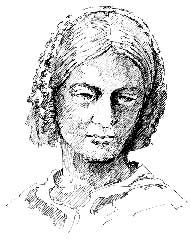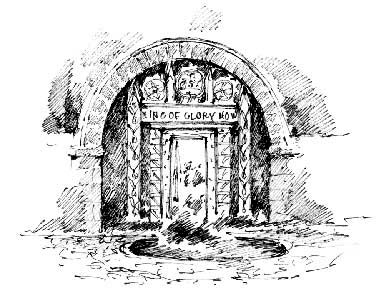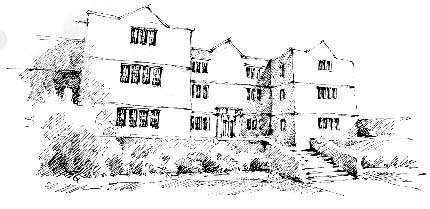Derbyshire
LADY WITH THE LAMP ∗ BABINGTON PLOT
∗ WELL DRESSING
Eyam Hall – 17th-century Hall at the heart of Derbyshire’s ‘Plague Village’, still in the hands of its original builders, the Wrights.
DERBYSHIRE FOLK
John Flamsteed ∗ James Brindley ∗ Herbert Spencer ∗ Barnes Wallis
∗ Dame Barbara Castle ∗ Alison Hargreaves
Florence Nightingale
1803–77
The village of Holloway is more or less a single street that winds along the hilltops above the River Derwent, near Matlock. Buried right in the middle of England, calm and peaceful, this was the perfect place for the most celebrated woman in England to come home to, away from the noise and filth of battle, the cries of the wounded, the stench of fear and death.
Early one summer evening in 1856, she walked down the short drive from the village street and knocked on the door of LEA HURST, the grey stone house built by her father. To the astonishment of her family, England’s ministering angel, FLORENCE NIGHTINGALE, was home from the war. Talked about all over Europe, she had slipped away from the Crimea, passed through London unnoticed and arrived home before anyone knew where she was. That was the way she wanted it. No triumphant homecomings or cheering crowds. Just the sound of the Derwent carried on the western breezes to her hilltop home.

Florence Nightingale was born in Florence in 1820. She was the daughter of a wealthy family and was expected to marry well and be the perfect young lady. Florence had other ideas. She was drawn to social issues and spent much of her childhood at Lea Hurst visiting local hospitals and the sick. To the huge embarrassment and disapproval of her family she took herself off to the Continent and trained as a nurse, before becoming a superintendent at a hospital for women in London.
When the Crimean War broke out in 1854, Florence appealed in person to Queen Victoria to be allowed to take a group of British nurses to Scutari and set up a military hospital. It was unheard of for women, especially well-to-do young women, to go to the battlefront, but they made huge improvements in the standards of hygiene and sanitation, and shamed the government into sending out proper medical supplies and food. Florence made regular inspections by the light of her lamp and saved the lives of countless numbers of soldiers. All this was at a cost to her own health, and after her sudden return to Lea Hurst it took several months of bracing Derbyshire air before she was well enough to start crusading again, this time creating a training school for nurses at St Thomas’s Hospital in London.
Florence Nightingale set the standards for modern nursing across the world. She overcame prejudice, ignorance and vested interests by sheer force of personality and was truly the first of the fearsome, battling Matrons – but to the men she tended she was just ‘our LADY WITH THE LAMP’.
Lea Hurst is now a residential home but it can be visited by appointment. It is easy to imagine Florence sitting on her favourite balcony, gazing across the garden with its gorgeous views, and jotting down her ideas for a better health service. She died in 1910 and is buried in East Wellow, Hampshire – THE FIRST WOMAN TO BE ADMITTED TO THE ORDER OF MERIT.
The Babington Plot
A few miles from Lea Hurst down country lanes, set back from the road behind a ring of noble trees, is the Manor Farm of DETHICK, looming over its tiny neighbouring church. In 1561 the lonely bells of this church rang out to welcome into the world the heir to this great estate, ANTHONY BABINGTON (1561–86), whose plottings, tragically, would destroy his ancient family.
The Babingtons were a wealthy Catholic family at a dangerous time, and young Anthony grew up in the remote safety of Dethick, which can hardly have changed since his time. At 16 he served as page to the captive Mary Queen of Scots and fell in love with her courage and beauty. He would frequently visit her in disguise while she was imprisoned at Wing-field House nearby, and fantasised about rescuing her and putting her on the throne.
Babington’s looks and wit made him a favourite at Queen Elizabeth’s court, but he grew over-confident, and was set up by Elizabeth’s protector Francis Walsingham. Mary Stuart’s supporters had devised a system of getting letters to her inside a special beer barrel sent from Burton on Trent every week. Walsingham’s spies knew about this but allowed the correspondence to continue, so that they could discover the identity of those in league with the exiled Scottish queen. In 1586 Babington wrote to Mary outlining what became known as the Babington Plot, a plan to use money and troops from Philip of Spain to capture London, murder Elizabeth and make Mary the Catholic queen of England and Scotland.
Babington and the ringleaders were arrested and charged with high treason, and they became THE LAST ENGLISH VICTIMS TO BE OFFICIALLY HUNG, DRAWN AND QUARTERED. This involved being dragged face down through the streets of London behind a horse, hung in Lincoln’s Inn Fields for a short period and then taken down, while still alive, to have their insides ripped out. Their agonies were so horrifying that even the bloodthirsty London crowds were appalled, and Elizabeth ordered that from that day on traitors were to be dead before they were taken down from the scaffold.
Well Dressing
WELL DRESSING is the decorating of wells, springs and water sources with pictures made from flowers and other natural materials. The pictures consist of a wooden frame and a clay base on to which the materials are fixed. The outline of the picture is picked out with berries, and then the more durable elements of the plants such as mosses, tree bark, lichens and fir cones are put on, and finally the colourful flower petals. It is a highly skilled procedure, and villages vie with each other to create the most imaginative and most appealing tableau.

The well dressing ceremony, which is unique to Derbyshire, originated in pagan Celtic times, when watercourses were uncertain and sacrifices were made to appease the water gods and thank them for keeping the village supplied. At first the Church frowned upon the revival of such practices, but soon relented, and today many of the pictures have a religious theme, or reflect a local or national anniversary. Most villages hold a church service to bless the well, followed by a carnival.
The season runs from May to September and a collecting box is kept nearby for donations to chosen charities.
Well, I never  knew this
knew this
about
DERBYSHIRE FOLK
JOHN FLAMSTEED (1646–1719), THE FIRST ASTRONOMER ROYAL, was born in DENBY, near Belper.
JAMES BRINDLEY (1716–72), canal engineer and builder of the first English canal of the modern era, the Bridgewater Canal, was born in TUNSTEAD, near Buxton. He designed and mapped out England’s 18th-century canal system, which helped transform England into an industrial nation.
HERBERT SPENCER (1820–1903), known as the founder of modern sociology, was born in DERBY. Spencer was a great supporter of Charles Darwin and, after reading Darwin’s theory of evolution in The Origin of Species, coined the phrase ‘survival of the fittest’, the concept on which he based his approach to social development.
BARNES WALLIS (1887–1979), inventor of the Bouncing Bomb, which destroyed the dams of the Ruhr valley in the Second World War, was born in RIPLEY.
ALISON HARGREAVES (1963–95), mountaineer, was born in BELPER. THE FIRST WOMAN TO CLIMB THE NORTH FACE OF THE EIGER and the FIRST CLIMBER EVER TO CLIMB SOLO THE SIX GREAT NORTH FACES OF THE ALPS IN ONE SEASON (Cima Grande di Laverado, Eiger, Grandes Jorasses, Matterhorn, Petit Dru and Piz Badile), she died in a storm while returning from the summit of the world’s second-highest mountain, K2.
DAME BARBARA CASTLE (1910–2002), politician, was born in CHESTERFIELD, a town celebrated for the gloriously warped and twisted spire of St Mary and All Saints church. As Minister for Transport in Harold Wilson’s government Barbara Castle was responsible for the introduction of the breathalyser test.








 knew this
knew this
